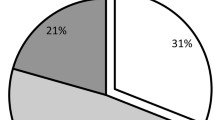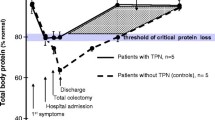Abstract
Background
Intensive care outcome measured by morbidity and mortality is altered in the severely malnourished ICU patient, and nutritional support of the critically ill is accepted as a standard of care. Current recommendations suggest starting enteral feeding as soon as possible whenever the gastrointestinal tract is functioning. The disadvantage of enteral support is that inadequate energy and protein intake can occur. The present commentary focuses on some recent findings regarding the nutritional support of critically ill patients and proposes to promote mixed nutrition support by enteral nutrition (EN), and by parenteral nutrition (PN) whenever EN is insufficient.
Recent findings
An increasing nutrition deficit during a long ICU stay is associated with increased morbidity (increased infection rate or impaired wound healing). Evidence shows that EN can result in underfeeding and that nutrition goals are reached only after 5–7 days. Contrary to former beliefs, recent meta-analyses of studies in the ICU showed that PN is not related to excess mortality but may even be associated with improved survival.
Conclusions
Optimising the increased substrate requirement for the critically ill by initiating timely nutrition support and ensuring tight glycaemic control with insulin is now considered central for improved intensive care outcomes. Supplemental PN combined with EN could be an effective alternative to achieve 100% of energy and protein targets at day 4, when EN alone fails to achieve goals greater than 60% by day 3. Whether such combined nutrition support provides additional benefit on overall outcome has to be ascertained in further studies.


Similar content being viewed by others
References
Berard MP, Zazzo JF, Condat P, Vasson MP, Cynober L (2000) Total parenteral nutrition enriched with arginine and glutamate generates glutamine and limits protein catabolism in surgical patients hospitalized in intensive care units. Crit Care Med 28:3637–3644
Monk DN, Plank LD, Franch-Arcas G, Finn PJ, Streat SJ, Hill GL (1996) Sequential changes in the metabolic response in critically injured patients during the first 25 days after blunt trauma. Ann Surg 223:395–405
Isenring EA, Capra S, Bauer JD (2004) Nutrition intervention is beneficial in oncology outpatients receiving radiotherapy to the gastrointestinal or head and neck area. Br J Cancer 91:447–452
Kyle UG, Genton L, Heidegger CP, Karsegard VL, Maisonneuve N, Huber O, Pichard C (2006) Hospitalized mechanically ventilated patients are at higher risk of enteral underfeeding than non-ventilated patients. Clin Nutr 25:727–735
Dempsey DT, Mullen JL, Buzby GP (1988) The link between nutritional status and clinical outcome: can nutritional intervention modify it? Am J Clin Nutr 47:352–356
Daley J, Khuri SF, Henderson W, Hur K, Gibbs JO, Barbour G, Demakis J, Irvin G 3rd, Stremple JF, Grover F, McDonald G, Passaro E Jr., Fabri PJ, Spencer J, Hammermeister K, Aust JB, Oprian C (1997) Risk adjustment of the postoperative morbidity rate for the comparative assessment of the quality of surgical care: results of the National Veterans Affairs Surgical Risk Study. J Am Coll Surg 185:328–340
Giner M, Laviano A, Meguid MM, Gleason JR (1996) In 1995 a correlation between malnutrition and poor outcome in critically ill patients still exists. Nutrition 12:23–29
Villet S, Chiolero RL, Bollmann MD, Revelly JP, Cayeux RNM, Delarue J, Berger MM (2005) Negative impact of hypocaloric feeding and energy balance on clinical outcome in ICU patients. Clin Nutr 24:502–509
Kyle UG, Genton L, Pichard C (2005) Hospital length of stay and nutritional status. Curr Opin Clin Nutr Metab Care 8:397–402
Berger MM, Chiolero RL, Pannatier A, Cayeux MC, Tappy L (1997) A 10-year survey of nutritional support in a surgical ICU: 1986–1995. Nutrition 13:870–877
Heyland D, Cook DJ, Winder B, Brylowski L, van deMark H, Guyatt G (1995) Enteral nutrition in the critically ill patient: a prospective survey. Crit Care Med 23:1055–1060
Genton L, Dupertuis YM, Romand JA, Simonet ML, Jolliet P, Huber O, Kudsk KA, Pichard C (2004) Higher calorie prescription improves nutrient delivery during the first 5 days of enteral nutrition. Clin Nutr 23:307–315
McClave SA, Sexton LK, Spain DA, Adams JL, Owens NA, Sullins MB, Blandford BS, Snider HL (1999) Enteral tube feeding in the intensive care unit: factors impeding adequate delivery. Crit Care Med 27:1252–1256
Adam S, Batson S (1997) A study of problems associated with the delivery of enteral feed in critically ill patients in five ICUs in the UK. Intensive Care Med 23:261–266
Bauer P, Charpentier C, Bouchet C, Nace L, Raffy F, Gaconnet N (2000) Parenteral with enteral nutrition in the critically ill. Intensive Care Med 26:893–900
Gramlich L, Kichian K, Pinilla J, Rodych NJ, Dhaliwal R, Heyland DK (2004) Does enteral nutrition compared to parenteral nutrition result in better outcomes in critically ill adult patients? A systematic review of the literature. Nutrition 20:843–848
Zaloga GP (1999) Early enteral nutritional support improves outcome: hypothesis or fact? Crit Care Med 27:259–261
Marik PE, Zaloga GP (2001) Early enteral nutrition in acutely ill patients: a systematic review. Crit Care Med 29:2264–2270
Artinian V, Krayem H, DiGiovine B (2006) Effects of early enteral feeding on the outcome of critically ill mechanically ventilated medical patients. Chest 129:960–967
Jolliet P, Pichard C, Biolo G, Chiolero R, Grimble G, Leverve X, Nitenberg G, Novak I, Planas M, Preiser JC, Roth E, Schols AM, Wernerman J (1998) Enteral nutrition in intensive care patients: a practical approach. Working Group on Nutrition and Metabolism, ESICM. European Society of Intensive Care Medicine. Intensive Care Med 24:848–859
Woodcock NP, Zeigler D, Palmer MD, Buckley P, Mitchell CJ, MacFie J (2001) Enteral versus parenteral nutrition: a pragmatic study. Nutrition 17:1–12
Reid CL, Campbell IT, Little RA (2004) Muscle wasting and energy balance in critical illness. Clin Nutr 23:273–280
Weissman C, Kemper M, Askanazi J, Hyman AI, Kinney JM (1986) Resting metabolic rate of the critically ill patient: measured versus predicted. Anesthesiology 64:673–679
De Jonghe B, Appere-De-Vechi C, Fournier M, Tran B, Merrer J, Melchior JC, Outin H (2001) A prospective survey of nutritional support practices in intensive care unit patients: What is prescribed? What is delivered? Crit Care Med 29:8–12
Dvir D, Cohen J, Singer P (2006) Computerized energy balance and complications in critically ill patients: an observational study. Clin Nutr 25:37–44
Mackenzie SL, Zygun DA, Whitmore BL, Doig CJ, Hameed SM (2005) Implementation of a nutrition support protocol increases the proportion of mechanically ventilated patients reaching enteral nutrition targets in the adult intensive care unit. JPEN J Parenter Enteral Nutr 29:74–80
Williams TA, Leslie GD (2005) A review of the nursing care of enteral feeding tubes in critically ill adults: part II. Intensive Crit Care Nurs 21:5–15
Heyland DK, Dhaliwal R, Day A, Jain M, Drover J (2004) Validation of the Canadian clinical practice guidelines for nutrition support in mechanically ventilated, critically ill adult patients: results of a prospective observational study. Crit Care Med 32:2260–2266
Martin CM, Doig GS, Heyland DK, Morrison T, Sibbald WJ (2004) Multicentre, cluster-randomized clinical trial of algorithms for critical-care enteral and parenteral therapy (ACCEPT). CMAJ 170:197–204
Spain DA, McClave SA, Sexton LK, Adams JL, Blanford BS, Sullins ME, Owens NA, Snider HL (1999) Infusion protocol improves delivery of enteral tube feeding in the critical care unit. JPEN J Parenter Enteral Nutr 23:288–292
Radrizzani D, Iapichino G (1998) Nutrition and lung function in the critically ill patient. Clin Nutr 17:7–10
Krishnan JA, Parce PB, Martinez A, Diette GB, Brower RG (2003) Caloric intake in medical ICU patients: consistency of care with guidelines and relationship to clinical outcomes. Chest 124:297–305
Takiguchi SA (1990) Report of a hidden case of overfeeding. Heart Lung 19:639–640
Klein CJ, Stanek GS, Wiles CE 3rd (1998) Overfeeding macronutrients to critically ill adults: metabolic complications. J Am Diet Assoc 98:795–806
Van den Berg B, Stam H (1988) Metabolic and respiratory effects of enteral nutrition in patients during mechanical ventilation. Intensive Care Med 14:206–211
Lo HC, Lin CH, Tsai LJ (2005) Effects of hypercaloric feeding on nutrition status and carbon dioxide production in patients with long-term mechanical ventilation. JPEN J Parenter Enteral Nutr 29:380–387
Rubinson L, Diette GB, Song X, Brower RG, Krishnan JA (2004) Low caloric intake is associated with nosocomial bloodstream infections in patients in the medical intensive care unit. Crit Care Med 32:350–357
Barr J, Hecht M, Flavin KE, Khorana A, Gould MK (2004) Outcomes in critically ill patients before and after the implementation of an evidence-based nutritional management protocol. Chest 125:1446–1457
Ibrahim EH, Mehringer L, Prentice D, Sherman G, Schaiff R, Fraser V, Kollef MH (2002) Early versus late enteral feeding of mechanically ventilated patients: results of a clinical trial. JPEN J Parenter Enteral Nutr 26:174–181
Hill SA, Nielsen MS, Lennard-Jones JE (1995) Nutritional support in intensive care units in England and Wales: a survey. Eur J Clin Nutr 49:371–378
Kudsk KA, Croce MA, Fabian TC, Minard G, Tolley EA, Poret HA, Kuhl MR, Brown RO (1992) Enteral versus parenteral feeding. Effects on septic morbidity after blunt and penetrating abdominal trauma. Ann Surg 215:503–511; discussion 511–503
Dhaliwal R, Jurewitsch B, Harrietha D, Heyland DK (2004) Combination enteral and parenteral nutrition in critically ill patients: harmful or beneficial? A systematic review of the evidence. Intensive Care Med 30:1666–1671
Kreymann KG, Berger MM, Deutz NE, Hiesmayr M, Jolliet P, Kazandjiev G, Nitenberg G, van den Berghe G, Wernerman J, Ebner C, Hartl W, Heymann C, Spies C (2006) ESPEN Guidelines on Enteral Nutrition: intensive care. Clin Nutr 25:210–223
Simpson F, Doig GS (2005) Parenteral vs. enteral nutrition in the critically ill patient: a meta-analysis of trials using the intention to treat principle. Intensive Care Med 31:12–23
Heyland DK, Dhaliwal R, Drover JW, Gramlich L, Dodek P (2003) Canadian clinical practice guidelines for nutrition support in mechanically ventilated, critically ill adult patients. JPEN J Parenter Enteral Nutr 27:355–373
Anderson AD, McNaught CE, MacFie J, Tring I, Barker P, Mitchell CJ (2003) Randomized clinical trial of multimodal optimization and standard perioperative surgical care. Br J Surg 90:1497–1504
Culebras JM, Martin-Pena G, Garcia-de-Lorenzo A, Zarazaga A, Rodriguez-Montes JA (2004) Practical aspects of peripheral parenteral nutrition. Curr Opin Clin Nutr Metab Care 7:303–307
Thomas DR, Zdrodowski CD, Wilson MM, Conright KC, Diebold M, Morley JE (2005) A prospective, randomized clinical study of adjunctive peripheral parenteral nutrition in adult subacute care patients. J Nutr Health Aging 9:321–325
Van den Berghe G, Wouters P, Weekers F, Verwaest C, Bruyninckx F, Schetz M, Vlasselaers D, Ferdinande P, Lauwers P, Bouillon R (2001) Intensive insulin therapy in the critically ill patients. N Engl J Med 345:1359–1367
Ellger B, Debaveye Y, Vanhorebeek I, Langouche L, Giulietti A, van Etten E, Herijgers P, Mathieu C, van den Berghe G (2006) Survival benefits of intensive insulin therapy in critical illness: impact of maintaining normoglycemia versus glycemia-independent actions of insulin. Diabetes 55:1096–1105
Brunkhorst FM, Kuhnt E, Engel C (2005) Intensive insulin therapy in patients with severe sepsis and septic shock is associated with an increased rate of hypoglycemia: results from a randomized multicenter study (VISEP). Infection 33:19–20
Van den Berghe G, Wilmer A, Hermans G, Meersseman W, Wouters PJ, Milants I, van Wijngaerden E, Bobbaers H, Bouillon R (2006) Intensive insulin therapy in the medical ICU. N Engl J Med 354:449–461
McWhirter JP, Pennington CR (1994) Incidence and recognition of malnutrition in hospital. BMJ 308:945–948
Jolliet P, Pichard C, Biolo G, Chiolero R, Grimble G, Leverve X, Nitenberg G, Novak I, Planas M, Preiser JC, Roth E, Schols AM, Wernerman J (1999) Enteral nutrition in intensive care patients: a practical approach. Clin Nutr 18:47–56
Author information
Authors and Affiliations
Corresponding author
Rights and permissions
About this article
Cite this article
Heidegger, CP., Romand, JA., Treggiari, M.M. et al. Is it now time to promote mixed enteral and parenteral nutrition for the critically ill patient?. Intensive Care Med 33, 963–969 (2007). https://doi.org/10.1007/s00134-007-0654-7
Received:
Accepted:
Published:
Issue Date:
DOI: https://doi.org/10.1007/s00134-007-0654-7




